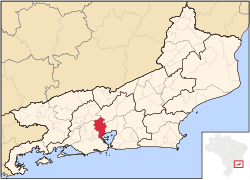This article needs additional citations for verification. (June 2014) |
Duque de Caxias | |
|---|---|
| Município de Duque de Caxias Municipality of Duque de Caxias | |
From top, left to right: skyline of Duque de Caxias; Church of Our Lady of the Pillar; pedestrian zone in downtown Duque de Caxias; house and chapel of the historic São Bento Farm | |
 Location of Duque de Caxias in the State of Rio de Janeiro | |
| Coordinates: 22°47′09″S 43°18′43″W / 22.78583°S 43.31194°W | |
| Country | |
| Region | Southeast |
| State | |
| Founded | 31 December 1943 |
| Government | |
| • Mayor | Washington Reis (2017–2021) |
| Area | |
| • Total | 464.573 km2 (179.373 sq mi) |
| Elevation | 7 m (23 ft) |
| Population (2022[1]) | |
| • Total | 808,161 |
| • Rank | 22th |
| • Density | 1,860.61/km2 (4,818.23/sq mi) |
| Demonym | Caxiense |
| Time zone | UTC−3 (BRT) |
| Postal Code | 25000-000 |
| Area code | +55 21 |
| Website | Duque de Caxias, Rio de Janeiro |
Duque de Caxias (Portuguese pronunciation: [ˈduki dʒi kaˈʃi.ɐʃ]; "Duke of Caxias") is a city on Guanabara Bay and part of Rio de Janeiro metropolitan area, southeastern Brazil.
It is bordered by Rio de Janeiro city to the south. Its population was 808,161 (2022) and its area is 465 km2, making it the second most populous suburb of Rio de Janeiro city.[2] The city is the third most populous in Rio de Janeiro Metropolitan Area, and also the third most populous city in Rio de Janeiro state. The current mayor is Washington Reis.
It is named after Luís Alves de Lima e Silva, Duke of Caxias, who was born there in 1803. The city is the seat of the Roman Catholic Diocese of Duque de Caxias. Its important industries are chemicals and oil refining.
Duque de Caxias Futebol Clube is the local football team of the city. The club plays their home matches at Estádio Romário de Souza Faria, which has a maximum capacity of 10,000 people. Estádio De Los Larios, located in the district of Xerém, has a maximum capacity of 11,000 people and it is the home ground of Esporte Clube Tigres do Brasil.
- ^ IBGE 2022
- ^ IBGE – "Archived copy". Archived from the original on 2007-01-09. Retrieved 2014-08-03.
{{cite web}}: CS1 maint: archived copy as title (link)






